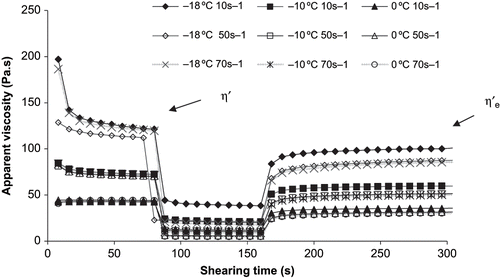Abstract
Data on flow properties of Frozen Concentrated Orange Juice (FCOJ) produced from oranges cv. Pera-Rio (65.04 °Brix, 8.8% w/w pulp content, 2.5% w/w pectin, 3.84% citric acid, 1.293 g cm−3) from −18 to 0°C were fitted with appropriate predictive models. The power law model was found to be the most appropriate to fit the flow curves obtained for FCOJ between 46.56 and 65.04 °Brix. In higher concentrations, thixotropy was observed and showed more temperature dependence. A single equation combining Arrhenius and exponential relationships was applied to describe the temperature effect and shear rate on the quantity of breakdown of FCOJ.
INTRODUCTION
Concentrated orange juice is one of the most important commodities worldwide and Brazil is the major producer (in 2003 it exported over 1 million of metric tons).[Citation1] In 2004, Brazil produced over 18 million metric tons of oranges, followed by U.S.A. that produced about 12 million metric tons.[Citation2] Citrus juices contain a wide variety of chemical compounds but none as prevalent as sugars or carbohydrates. Because of this, they are manufactured at a variety of concentrations or Brix levels, which can be adjusted up or down by using commercial evaporators, blending or adding water. Therefore, it is often more convenient to base marketing, packaging, and inventory systems on the weight of soluble solids without water, rather than on the volume of the juice.
Knowledge of rheological behavior of frozen concentrated orange juice (FCOJ) based on soluble solids content is quite important in quality control, storage and processing. In addition, accurate measurements of rheological data are necessary for the flow transport, as sizing of pumps and piping. The temperature and soluble solids content influence the rheological behavior of FCOJ and are responsible for non-Newtonian flow behavior. Several studies have been conducted on the rheological properties of fruit purees and concentrates indicating influence of temperature,[Citation3–9] total soluble solids/concentration,[Citation10–12] and pH[Citation7–9] on flow behavior. Quite a few authors[Citation13–15] reported that fruit concentrate and puree exhibited thixotropic behavior, related to pectin content, fibers, and pulp content, though none of them reported thixotropic data at subzero temperatures. Ramos and Ibarz[Citation13] reported that orange concentrate with pulp and pectin presented thixotropic behavior at soluble solids concentrations of 55 and 60 °Brix, temperature range from 0 to 20°C and shear rate interval from 7.2 to 57.6 s−1. The thixotropic behavior was described by a kinetic model.
Thixotropy describes the behavior of substances that change from a gel state of high viscosity to a much lower viscosity sol as the result of exerted high shear during some extended test periods. An important criterion for thixotropy is the reversible process of re-thickening of the substance when left at rest. The time dependence is related to the structural change due to shear. If shear ceases, the viscosity can return to its initial value because of structural recovery of the material. This study aimed to obtain data on flow properties of Frozen Concentrated Orange Juice (FCOJ) produced from oranges cv. Pera-Rio from −18 to 0°C and study the effects of temperature and shear rate on its thixotropic behavior. This temperature interval was chosen because the flow transport of FCOJ is done at temperatures within this range.
MATERIAL AND METHODS
Sample Preparation
All experimental measurements were conducted with samples from the same batch of Frozen Concentrated Orange Juice (FCOJ) produced from oranges of Pera-Rio variety (65.04 °Brix, 8.8% w/w pulp content, 2.5% w/w pectin, 3.84% citric acid, 1.293 g.cm−3) in a 7–stage TASTE® evaporator (FMC FoodTech, USA) and stored at −30°C. The FCOJ was supplied by a citrus industry in the region of São Paulo State, Brazil. In order to obtain different concentrations, FCOJ was diluted with distilled water.
Analytical Measurements
Citric acid was determined, in triplicate, according to Kimball[Citation16] conducted in the pH-STAT (RADIOMETER, mod. PHM290, France). Soluble solids were determined, in triplicate, by a refractometer (CARLZEISS JENA, mod. 711849, Germany) and corrected for acidity and temperature values according to Kimball.[Citation16]
Rheological Measurements
Rheological measurements were carried out using a rheometer (model MCR 300, Physica, Austria) with plate/plate geometry (49.96 mm), interfaced to a microcomputer for control and data acquisition. A steady shear rate sweep was performed to determine the dependence of apparent viscosity and shear stress with rate. First, the sweep was performed by increasing shear rate from 0 to 100 s−1 (2 s−1 steps) and then the shear rate was decreased back to the initial value using the same sample at constant temperature. The sample compartment was maintained at a constant temperature using a Peltier temperature controller from −40 to +150°C. The experiments were repeated twice, at least, always using a new FCOJ sample, to avoid the effect of shear history. Shear stress–shear rate data were gathered as flow curves. The flow curves were obtained for FCOJ between 46.56 to 65.04 °Brix at a temperature range from −18 to 0°C.
For the thixotropy characterization the same rheometer was used and working temperatures of −18°C, −10°C and 0°C and shear rates of 10 s−1, 50 s−1, and 70 s−1 were chosen, typical values for flow transportation of FCOJ used by citrus industries. Curves were obtained from the variation of shear stress with time for 10 min at each constant shear rate. For measuring the rate of recovery of the gel structure of FCOJ, a two-phased test was conducted: at a shear rate of 1 s−1 simulating a ‘close to stand-still-condition’ during 50 s, 50 s at a constant level of high shear rate (10 s−1, 50 s−1 and 70 s−1) followed by a recovery time of 500 s at shear rate of 1 s−1.
Data Analysis
Fitted models were obtained by using nonlinear estimation procedure from the statistical program Statistica® v. 7.0 (Statsoft, USA). The suitability of the fitted models was evaluated by the determination coefficient (r2), the significance level (p < 0.05), and residual analysis. Experimental data obtained from thixograms were fitted by an empirical structural model proposed by Figoni and Shoemaker.[Citation17]
RESULTS AND DISCUSSION
shows the results of citric acid and soluble solids content of different concentrations of FCOJ samples used for rheological measurements. The flow curves were obtained for FCOJ at 46.56, 49.96, 56.33 58.56, 64.29, and 65.04°Brix, in triplicate, at temperatures −18, −16, −14, −12, −10, −8, −6, −4, −2 and 0°C, depending on the concentration, always beginning at a temperature above the freezing point depression, which ranges from −18.83°C for 66.0 °Brix to −9.89°C for 46.0°Brix.[Citation18] Typical shear stress-shear rate curves for FCOJ at −18 to 0°C temperature range obtained for 65.04 °Brix are shown in . A clearly non-Newtonian behavior of a shear-thinning (pseudoplastic) fluid was observed. Similar curves were obtained for all concentrations and temperatures. Vitali and Rao[Citation10] reported the same flow behavior for 65 °Brix low-pulp concentrated orange juice between −19 and 30°C. The presence of some hysteresis loops in the flow curves is an indication of shearing effects on the molecular structure of FCOJ. This resulted on a decrease of apparent viscosity. The hysteresis loops indicate that the degree of thixotropy (if present) is small. However, the hysteresis loops of the flow curves cannot be used quantitatively to determine the effect of solids concentration on the thixotropic behavior of FCOJ, at subzero temperatures.
Figure 1 Typical shear stress – shear rate curves of Frozen Concentrated Orange Juice (FCOJ) at 65.04 °Brix within the temperature range from −18°C to 0°C.
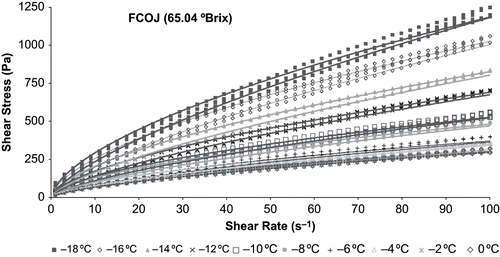
Table 1 Citric acid and soluble solids content of FCOJ according to concentration
The shear rate–shear stress data at all concentrations were well described by the power law model with negligible yield stress values. Other rheological models, such as the Herschel-Bulkley model, were tested, but did not adequately fit the flow curves. Parameters obtained for the power-law model are summarized in . The coefficients of determination, for all cases, were higher than 0.995. FCOJ for all concentrations and temperatures exhibited a power-law shear thinning behavior, characterized by flow behavior index values less than 1. As can be observed the consistency index increased as concentration increased and decreased as temperature increased. ANOVA applied to the results indicated that both concentration and temperature significantly influenced the consistency index (p < 0.05). However, only concentration influenced the flow behavior index.
Table 2 Power-law parameters of Frozen Concentrated Orange Juice (FCOJ) at different concentrations and temperatures
Non-linear regression analysis was performed to obtain the combined effect of temperature and concentration on the consistency index obtained from forward curves. A single equation was derived by combining the Arrhenius and exponential relationships as follows:
where: A is adjusted model parameter (=1.11 × 10−13 Pa sn); B is adjusted model parameter (=0.21 °Brix−1); C is concentration (°Brix); Ea is activation energy (=44,103.5 kJ kmol−1); T is temperature (K); R is universal gas constant (8.315 kJ kmol−1 K−1). The parameters of Equationequation 1 were obtained by non-linear regression of experimental data, through Marquardt procedure and the adjusted determination coefficient was r2 adj. = 0.959. shows the response surface obtained from EquationEq. 1. Similar equations have been used by many authors for tomato concentrates,[Citation19] for concentrated orange juice,[Citation5, Citation22] for concentrated kiwi juice,[Citation20] for peach and plum puree,[Citation21] for mango, papaya and peach puree,[Citation8] and for banana puree.[Citation7]
Figure 2 Response surface representing the effect of temperature (T) and soluble solids content (C) on the consistency index (K) of Frozen Concentrate Orange Juice (FCOJ).
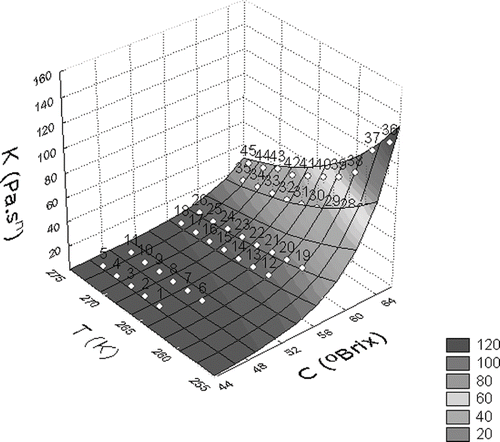
A single exponential model for the flow behavior index was obtained (EquationEq. 2) with r2 adj. = 0.851:
The experimental data obtained in this paper for the consistency index and flow behavior index varied from 20 to 120 Pa.sn and from 0.53 to 0.57, respectively, values quite similar presented by Krokida et al.[Citation23] for orange juice. FCOJ viscosity showed stronger time dependence at higher concentrations. shows the shear behavior at three different shear rates (10 s−1, 50 s−1, 70 s−1) for FCOJ at 65.04 °Brix at −18°C, −10°C, and 0°C.
Figure 3 Typical thixograms of FCOJ at 65.04 °Brix at different temperatures (−18°C, −10°C, and 0°C) and at different shear rates (10 s−1, 50 s−1, 70 s−1).
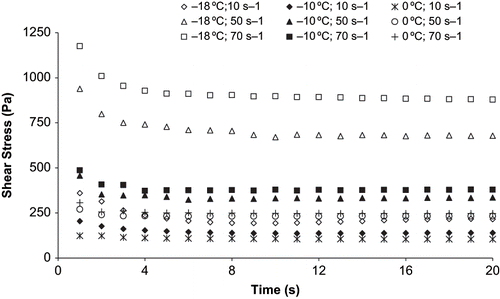
It can be observed that the thixograms for lower temperatures and higher shear rates present two segments. The first one shows a rapid decrease of shear stress up to 4 s, while the second presents a significantly slower decrease. Ramos and Ibarz[Citation13] reported the same behavior for orange juice at 55 °Brix and 60 °Brix, at working temperatures of 0°C, 5°C, 10°C and 20°C. These authors suggested that the first decrease occurred probably because of the disintegration of irregular pulps into smaller and more homogeneous particles, and the second decrease is due to orientation of particles caused by the shearing action. Figoni and Shoemaker[Citation17] proposed an empirical structural model to characterize time dependent flow properties of mayonnaise (EquationEq. 3):
where: σ is shear stress (Pa), σ e is shear stress equilibrium value (Pa); σ I is initial shear stress (Pa); (σ I – σ e ) is quantity of structural breakdown by shearing (Pa); k is kinetic structural destruction constant (s−1); and t is shearing time (s). Experimental values obtained from each thixogram were fitted to Figoni and Shoemaker[Citation17] model and the thixotropic parameters are listed in . It can be observed that the quantity of structural breakdown (σ i – σ e ) after shearing presented a clear tendency, at the same temperature, while at lower shear rates, smaller values of equilibrium shear stress (σ e ) were found, implying smaller apparent final viscosities. Ramos and Ibarz[Citation13] reported same tendencies for equilibrium shear stress studying concentrate orange juice. The same behavior was observed in FCOJ at other concentrations.
Table 3 Figoni and Shoemaker modelFootnote 1 parameters for FCOJ at 65.04 °Brix at three different working temperatures (−18°C, −10°C, and 0°C) and at three different shear rates (10 s−1, 50 s−1, 70 s−1)
ANOVA indicated that temperature significantly influenced initial shear stress and the quantity of structural breakdown (see ). Both σ i and (σ i – σ e ) decreased as temperature increased, as expected, indicating that at lower FCOJ temperatures, the behavior is more thixotropic. However, shear rate only influenced the quantity of breakdown of FCOJ. Both σ i and σ e increased as shear rate increased. Ramos and Ibarz[Citation13] observed the same tendencies. The combined effect of temperature and shear rate for the quantity of breakdown can be expressed by one equation (EquationEq. 4) for FCOJ at 65.04 °Brix. The effect of shear rate and temperature on the thixotropic character of the FCOJ is presented in :
Table 4 Effect of shear rate and temperature on Figoni and Shoemaker modelFootnote 1 parameters for FCOJ at 65.04 °Brix
Figure 4 Response surface representing the effect of temperature (T) and shear rate () on the quantity of structural breakdown by shearing (σ
i
– σ
e
) of Frozen Concentrate Orange Juice (FCOJ) at 65.04 °Brix.
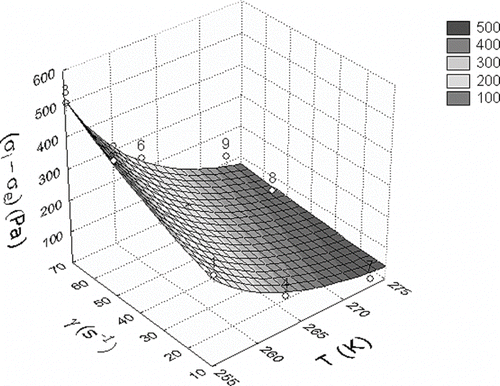
where: (σ
i
– σ
e
) is quantity of structural breakdown by shearing (Pa); Ea is activation energy ( = 56,055.2 kJ.kmol−1); T is temperature (K); R is universal gas constant ( = 8.315 kJ.kmol−1.K−1); and is shear rate (s−1). The parameters of Equationequation 4 were obtained by non-linear regression of experimental data, through Marquardt procedure and the adjusted determination coefficient was r2
adj. = 0.985. shows typical curves obtained from two-phased tests for FCOJ at 65.04 °Brix. The recovery of the structure was measured from the ratio of equilibrium apparent viscosity reached after the applied high shear rate (η′e), and the equilibrium apparent viscosity (ηe) at ‘close to stand-still-condition’. ANOVA indicated that both temperature and shear rate significantly influenced the structural recovery. The rate of recovery ranged from 70.7 to 83.0% according to temperature variation and from 75.1 to 77.3% according to shear rate variation. Increasing temperature and shear rate, the structural recovery rate decreased.
CONCLUSION
Frozen concentrate orange juice (FCOJ) presents a pseudoplastic behavior for all concentrations studied within the temperature interval from −18 to 0°C, when up and down curves were performed. A single equation derived by combining the Arrhenius and exponential relationships was used to describe the temperature and concentration dependence of consistency index. A single exponential model was obtained to describe the concentration dependence on flow behavior index. FCOJ also presents a strong time dependent rheological behavior, at higher concentrations. Experimental data were fitted to a structural model to correlate initial shear stress, equilibrium shear stress and quantity of structural breakdown during shearing. Two–phased tests for FCOJ at 65.04 °Brix indicated a rate for structural recovery from 70.7 to 83.0% according to temperature variation and from 75.1 to 77.3% according to shear rate variation. These results presented in this article are quite useful for accurate design of pumps and piping for FCOJ for shipping.
ACKNOWLEDGMENTS
The authors wish to thank BASCITRUS S.A. for helpful suggestions and sample material supply; João Jesuino Demilio for technical support; and to State of São Paulo Research Foundation (FAPESP) for financial support.
REFERENCES
- Food and Agriculture Organization (FAO), FAOSTAT Database Collections, 2003 www.fao.org/faostat/ (Accessed: 21 September 2005 ).
- Food and Agriculture Organization (FAO), FAOSTAT Database Collections, 2004 www.fao.org/faostat/ (Accessed: 21 September 2005 ).
- Saravacos , G.D. 1970 . Effect of Temperature on Viscosity of Fruit Juices and Purees . J. Food Sci. , 35 : 122 – 125 .
- Holdsworth , S.D. 1971 . Applicability of Rheological Models to the Interpretation of Flow and Processing Behavior of Fluid Food Products . J. Texture Stud. , 2 : 393 – 418 .
- Vitali , A.A. and Rao , M.A. 1984 . Flow Properties of Low-Pulp Concentrated Orange Juice: Serum Viscosity and Effect of Pulp Content . J. Food Sci. , 49 : 876 – 881 .
- Ditchfield , C. , Tadini , C.C. , Singh , R.K. and Toledo , R.T. 2004 . Rheological Properties of Banana Puree at High Temperature . International Journal of Food Properties , 7 ( 3 ) : 571 – 584 .
- Guerrero , S.N. and Alzamora , S.M. 1997 . Effect of pH, Temperature and Glucose Addition on Flow Behavior of Fruit Purées: I. Banana purée. . J. Food Eng. , 33 : 239 – 256 .
- Guerrero , S.N. and Alzamora , S.M. 1998 . Effect of pH, Temperature and Glucose Addition on Flow Behavior of Fruit Purées: II. Peach, Papaya and Mango Purées . J. Food Eng. , 37 : 77 – 101 .
- Ahmed , J. and Ramaswamy , H.S. 2004 . Response Surface Methodology in Rheological Characterization of Papaya Puree . International Journal of Food Properties , 7 ( 1 ) : 45 – 58 .
- Vitali , A.A. and Rao , M.A. 1984 . Flow Properties of Low-pulp Concentrated Orange Juice: Effect of Temperature and Concentration . J. Food Sci. , 49 : 882 – 888 .
- Ilicali , D.R.C. 1985 . Correlation for the Consistency Coefficients of Apricot and Pear Purees . J. Food Eng. , 8 : 47 – 51 .
- Hernandez , E. , Chen , C.S. , Johnson , J. and Carted , R.D. 1995 . Viscosity Changes in Orange Juice after Ultrafiltration and Evaporation . J. Food Eng. , 25 : 387 – 396 .
- Ramos , A.M. and Ibarz , A. 1998 . Thixotropy of Orange Concentrate and Quince Puree . J. Texture Stud. , 29 : 313 – 324 .
- Mizrahi , S and Berk , Z. 1970 . Flow Behavior of Concentrated Orange Juice . J. Texture Stud. , 1 : 342 – 355 .
- Crandall , P.G. , Davis , K.C. and Baker , R.A. 1990 . Viscosity of Orange Juice Concentrate by Pulp Reduction by Enzyme Treatment . Food Technol. , 44 ( 4 ) : 126 – 129 .
- Kimball , D.A. 1991 . Citrus Processing: Quality Control and Technology , 473 New York : Chapman & Hall .
- Figoni , P.I. and Shoemaker , C.F. 1983 . Characterization of Time-dependent Flow Properties on Mayonnaise under Steady Shear . J. Texture Stud. , 114 : 431 – 442 .
- Gabas , A.L. , Telis-Romero , J. and Telis , V.R.N. 2003 . Influence of Fluid Concentration on Frozen Point Depression and Thermal Conductivity of Frozen Orange Juice . International Journal of Food Properties , 6 : 543 – 556 .
- Harper , J.C. and El Sharigi , A.F. 1965 . Viscometric Behavior of Tomato Concentrates . J. Food Sci. , 30 : 470 – 478 .
- Ibarz , A. , Giner , J. , Pagán , J. , Gimeno , V. and Garzas , S. 1995 . Rheological Behavior of Kiwi Fruit Juice Concentrates . J. Texture Stud. , 26 : 137 – 145 .
- Ibarz , A. and Lozano , J.E. 1992 . Caracterización Reológica de Pulpas Concentradas de Ciruela y Melocotón. . Rev. Esp. Ciencia y Tecnología de Alimentos , 32 ( 1 ) : 85 – 94 .
- Berto , M.I. , Silveira Jr , V. and Vitali , A. 2003 . A. Mathematical Models for the Prediction of Rheological Parameters of Brazilian Concentrate Orange Juices . J. Food Sci. Technol. , 404 : 366 – 370 .
- Krokida , M.K. , Maroulis , Z.B. and Saravacos , G.D. 2001 . Rheological Properties of Fluid Fruit and Vegetable Puree Products: Compilation of Literature Data . International Journal of Food Properties , 4 ( 2 ) : 179 – 200 .
